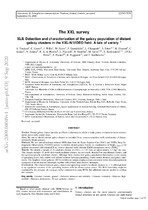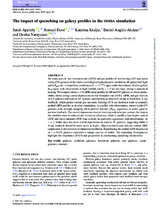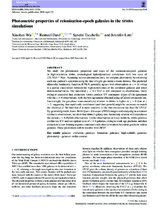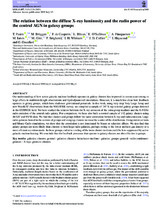The XXL survey XLII. Detection and characterization of the galaxy population of distant galaxy clusters in the XXL-N/VIDEO field: A tale of variety
Abstract
Context. Distant galaxy clusters provide an effective laboratory in which to study galaxy evolution in dense environments and at early cosmic times.
Aims. We aim to identify distant galaxy clusters as extended X-ray sources coincident with overdensities of characteristically bright galaxies.
Methods. We use optical and near-infrared (NIR) data from the Hyper Suprime-Cam (HSC) and VISTA Deep Extragalactic Observations (VIDEO) surveys to identify distant galaxy clusters as overdensities of bright, zphot ≥ 0.8
galaxies associated with extended X-ray sources detected in the ultimate XMM extragalactic survey (XXL).
Results. We identify a sample of 35 candidate clusters at 0.80 ≤ z ≤ 1.93 from an approximately 4.5 deg2
sky area.
This sample includes 15 newly discovered candidate clusters, ten previously detected but unconfirmed clusters, and
ten spectroscopically confirmed clusters. Although these clusters host galaxy populations that display a wide variety
of quenching levels, they exhibit well-defined relations between quenching, cluster-centric distance, and galaxy luminosity. The brightest cluster galaxies (BCGs) within our sample display colours consistent with a bimodal population
composed of an old and red subsample together with a bluer, more diverse subsample.
Conclusions. The relation between galaxy masses and quenching seem to be already in place at z ∼ 1, although there
is no significant variation of the quenching fraction with the cluster-centric radius. The BCG bimodality might be
explained by the presence of a younger stellar component in some BCGs but additional data are needed to confirm
this scenario.
Collections
Related items
Showing items related by title, author, creator and subject.
-
The impact of quenching on galaxy profiles in the SIMBA simulation
Dave, Romeel; Appleby, Sarah; Kraljic, Katarina (Oxford University Press, 2020)We study specific star formation rate (sSFR) and gas profiles of star-forming (SF) and green valley (GV) galaxies in the SIMBA cosmological hydrodynamic simulation. SF galaxy half-light radii (Rhalf) at z = 0 and their ... -
Photometric properties of reionization-epoch galaxies in the SIMBA simulations
Dave, Romeel; Wu, Xiaohan; Tacchella, Sandro (Oxford University Press, 2020)We study the photometric properties and sizes of the reionization-epoch galaxies in high-resolution SIMBA cosmological hydrodynamical simulations with box sizes of [25,50]h−1Mpc. Assuming various attenuation laws, we ... -
The relation between the diffuse X-ray luminosity and the radio power of the central AGN in galaxy groups
Jarvis, M.; Pasini, T.; Bruggen, M. (Oxford University Press, 2020)Our understanding of how active galactic nucleus feedback operates in galaxy clusters has improved in recent years owing to large efforts in multiwavelength observations and hydrodynamical simulations. However, it is much ...




